How to eat sushi more deliciously
When enjoying sushi, there are no complicated rules of conduct you need to follow, like those you need to for a tea ceremony. However, there are ways to eat sushi that will enhance the experience.
A frequently raised question is whether to eat by hand or by using chopsticks. During the times when the nigiri sushi made its debut, people were in the habit of enjoying the dish by hand at yatais (food stalls), where standing and eating was the order of the day. But as time passed, the custom of sitting down, even at counters, was introduced, along with the use of chopsticks. So whichever way is appropriate, but eating by hand helps you enjoy sushi more easily, since doing so helps you prevent rice from spilling and makes it easier to dip the delicacy into some soy sauce.However, prior to eating, make sure you wash your hands well.
Whichever method you opt for in the end, if you are going to eat nigiri sushi, avoid removing the topping and eating it separately from the rice. Also, avoid going overboard with the soy sauce.
How to eat using chopsticks
-
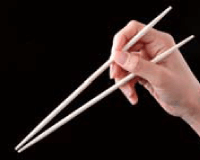
– Hold the chopsticks by grasping them between your thumb and forefinger and positioning your middle finger between the two sticks, moving only the upper stick when necessary.
-
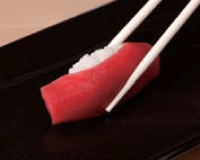
– Grasp the middle part of the sushi with the chopsticks, lay sideways, and then pick up.
-
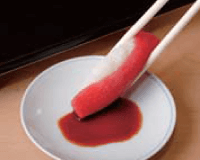
– Tilt the topping downward and dab soy sauce onto its tip.
How to eat by hand
-
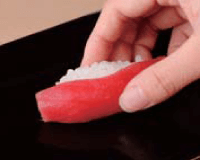
– Wipe your hands well with an oshibori (a moist hand towel), and then lay the sushi sideways by lightly grasping it, using your thumb, forefinger, and middle finger.
-
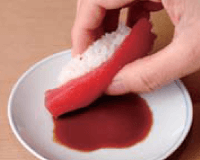
– The material is made to become below, and the soy sauce is applied only a little ahead.
Sushi to be enjoyed without soy sauce
Some sushi are more enjoyable without flavoring them with soy sauce. Such sushi, as a general rule, are those with cooked ingredients spread over the topping, such as sea eel, giant clam, clam, and cooked cuttlefish. In addition, tamago yaki (fried egg), kanpyo maki (dried gourd shavings roll), futomaki (thick rolls), and date-maki (futomaki wrapped with sweet-tamagoyaki) are also sushi you should not flavor with soy sauce, as a general rule. These sushi are usually premium dishes that offer distinctive flavors of the restaurant in which they are served, so it is a good idea to enjoy them without seasoning. In addition, you should avoid seasoning sushi with a topping that has already been seasoned with soy sauce by the itamae (chef). When in doubt, don’t hesitate to ask him. He will advise you in a friendly manner.
The hakozushi has its origins in Osaka and remains very popular in the Kansai region to this day. This type of sushi is enjoyed without soy-sauce flavoring and is prepared with shrimp, sea eel, or omelet boiled or roasted beforehand.
Either of these ingredients is placed atop the shari compacted in a wooden box, strongly pressed, and then cut into pieces. Since the ingredient found between the topping and shari is flavored, along with the shari itself, if you add some soy sauce the original flavor will be lost. The connoisseur will also refrain from applying soy sauce on the bouzushi variety (literally "rod sushi" variety), which includes the battera sushi and the matsumae sushi popular in the Kansai area.
Sushi that cannot be easily seasoned with soy sauce
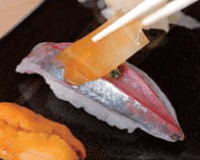
It is not easy to apply soy sauce to gunkan sushi (battle ship-like sushi), such as uni (sea urchin) and ikura (salmon roe) or to sushi like aji (horse mackerel) that are topped with condiments like ginger and leek. For such types of sushi, pick up a small portion of gari (pickled ginger), dip it into soy sauce, and brush the topping with this ginger to season with soy sauce.
The order in which sushi should be eaten
There is no particular order in which sushi should be eaten and there is nothing wrong in starting from your favorite dish. However, you may find it more pleasurable to start with a sushi dish that has a plain topping, such as whitefish, and keep working your way up to more stronger flavored ones, finishing with a refreshing dish, such as kappa maki (cucumber roll) or oshinko maki (pickled roll).
Rice portion
You can freely order how much rice you would like your nigiri sushi to be prepared with. Just say ookimeni (large portion) or futsuni (normal portion) or koburuni (small portion), and the itamae (chef) will gladly comply.
The role of tea
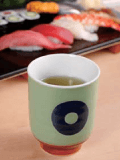
The tea served at sushi restaurants is for removing any aftertaste. Specifically, the idea behind serving a full cup of hot tea is to wash down the aftertaste of the fish that remains after eating sushi, before enjoying your next one.
If the taste of the tea itself is on the strong side, the inherent tasty flavor of the sushi may turn bad. For this reason, either powdered tea or bancha (Japanese tea of ordinary quality) is most suitable for serving at sushi restaurants.



